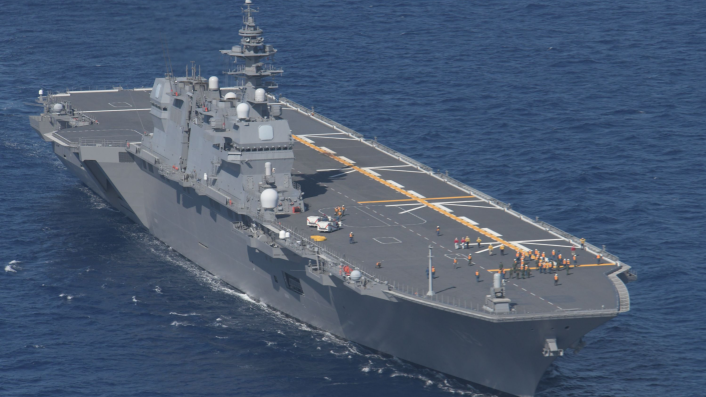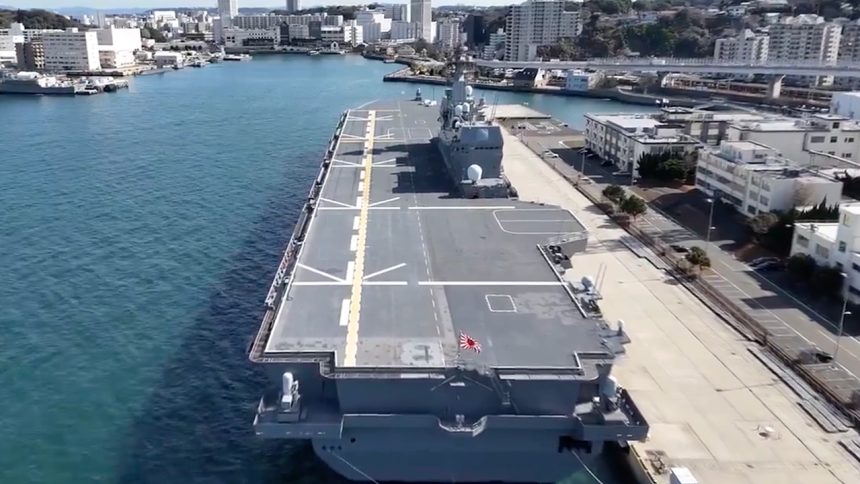A drone was able to fly close to aircraft carriers and warships at Yokosuka Naval Base, exposing security failures, while person who shot the footage apologized.
A drone footage of the JMSDF (Japan Maritime Self-Defense Force) helicopter carrier JS Izumo at the Yokosuka naval base, appearing on Chinese social media networks in March and on X this month, has sent Japanese defense and security officials into a tizzy.
The video revealed massive security lapses at a frontline naval facility hosting a flagship vessel. The person who flew the UAV (unmanned aerial vehicle), currently in China, has since then apologized for the incident and maintained that he did not intend to provoke a diplomatic and security incident.
The JS Izumo, is originally a massive “helicopter carrier,” but is currently in the last stages of being modified to carry VTOL (Vertical Take-Off Landing) F-35Bs, to be converted into a “Lighting carrier.” A need for having smaller carriers to be able to carry pure fifth generation stealth fighters like the F-35 has emerged surging strategic and military tensions with China in the Indo-Pacific.
But the incident reveals a massive techno-commercial dimension. The rise of the global private technology and drone sector has made available a variety of commercial off-the-shelf drones for leisure use. The war in Ukraine showed how such small UAVs can be retrofitted for military use, for everything from simple battlefield surveillance, artillery fire correction to kamikaze attack roles by being strapped with explosives.
𝗖𝗵𝗶𝗻𝗲𝘀𝗲 𝗱𝗿𝗼𝗻𝗲 𝗰𝗮𝗿𝗿𝗶𝗲𝗱 𝗼𝘂𝘁 𝘀𝗶𝗺𝘂𝗹𝗮𝘁𝗲𝗱 𝗮𝘁𝘁𝗮𝗰𝗸 𝗼𝗻 𝗮𝗶𝗿𝗰𝗿𝗮𝗳𝘁 𝗰𝗮𝗿𝗿𝗶𝗲𝗿 𝗜𝘇𝘂𝗺𝗼
A Chinese man has released a video of a small drone costing about 100,000 yen flying at low altitude just above Izumo, part of the Japan Maritime… pic.twitter.com/8cZ9SJSs6M
— Rakshita Nagar (@RakshitaNagar) March 30, 2024
What the Video Captured
According to Nikkei Asia the “overhead drone footage of Japan’s largest destroyer” triggered “grave concerns” about the Japanese military’s ability “to detect potential threats” after it first appeared on Chinese video-sharing platform Bilibili. On May 9, 2024, Japan’s Defense Ministry said it determined the video to be “authentic” and that a drone likely flew over Yokosuka naval base to videograph the warship.
The @Xiao_Hao_4 account on X, claiming to have flown the drone, posted the 19-second high resolution video, showing the Izumo’s flight deck. The footage shows the deck being approached from the stern and proceeding to go all the way to the bow. Since then, the account posted additional videos purporting to also show the USS Ronald Reagan and two US Navy Aegis destroyers at Yokosuka. One of the warships is undergoing repairs.
— 这是我小号4 (@Xiao_Hao_4) May 8, 2024
中国无人机飞翔在星条旗之上 pic.twitter.com/oL38WSQeka
— 这是我小号4 (@Xiao_Hao_4) May 14, 2024
NCIS (Naval Criminal Investigative Service) “investigated their authenticity according to Stars and Stripes but the investigation revealed no indication that a drone flew over the Ronald Reagan, Keller added. This is weird as the footage and images, later confirmed to be genuine, seem to confirm the drone flew, if not directly over the US aircraft carrier, close enough to take some pretty good shots.
— 这是我小号4 (@Xiao_Hao_4) April 4, 2024
The drone is far from being able to cause major structural damage or sink the ship. But had it been carrying explosives, it could have easily exploded near one of the delicate radars, communication systems that are extremely intricately engineered. The systems have a host of microelectronics, processors and electrical circuitry that is tedious to manufacture, put together and replace. The damage assessment and repairs would have easily taken months.

Person Apologizes
The person who posted the video was soon interviewed by Kyodo News over chat messaging service, saying he left Japan after taking the footage and is currently in China. He acknowledged he was aware the act was illegal and promised not to do it again. “I do not have intention to provoke international conflict. I just did it for fun,” he said.
A screenshot of the chat is seeing the reporter asking whether the person “knew” what he was doing, aware that it was “prohibited,” or did it as a “radical prank” and if he “loved warships?”
The person responded that while he has “some knowledge” about warships, he realized “it is too risky…and will not do such things again.” He responded in the affirmative saying he “feels danger,” when asked if he perceived a “personal safety” threat following the incident.
Security Lapses Exposed
Japanese law bans unauthorized flights of unmanned aerial vehicles near JSDF and US military bases, the prime minister’s office, nuclear reactors and “other sensitive sites that could be targeted by terrorist attacks or espionage activities.” These areas are classified as “red zones,” while areas within about a 300-meter radius of the facilities are called “yellow zones.”
“We take this matter very seriously. As there is a possibility of unmanned aerial vehicles becoming more difficult to detect, we will ensure the base is thoroughly secure,” Defense Minister Minoru Kihara said at a press conference last week.
The JSDF’s monitoring and surveillance capabilities are focused on the interior of its bases, not on activities outside the installations, leaving a gray area as to which body was responsible for securing the airspace.
榛葉氏は撮影者の名前を把握しているが、読み方が分からないとも言及した。
It seems that the Japanese government knows my name, but they do not know how to pronounce it?
If you know my name, just say it, or I think you are deceiving yourself.https://t.co/iKwgCHJOXj
— 这是我小号4 (@Xiao_Hao_4) May 15, 2024
Nikkie Asia quoted scientists and MoD officials who said small drones can sometimes be “mistaken” for birds, while fast moving, high-speed drones capable of tight maneuvers “cannot be tracked continuously.” The MoD is now “considering rolling out equipment with elevated detection capabilities,” indicating it might introduce specialized anti-drone radars and counter-UAV systems.
“In the war between Russia and Ukraine, both sides have struggled to respond to drone attacks. Drones are cheaper than missiles and can be acquired in the civilian marketplace. Non-military drones can be modified into weapons.”
The drone that filmed the Izumo is “thought to be a small model found in the civilian marketplace.” Though such drones are “less advanced” than military ones, they can “act as decoys,” the report added.









